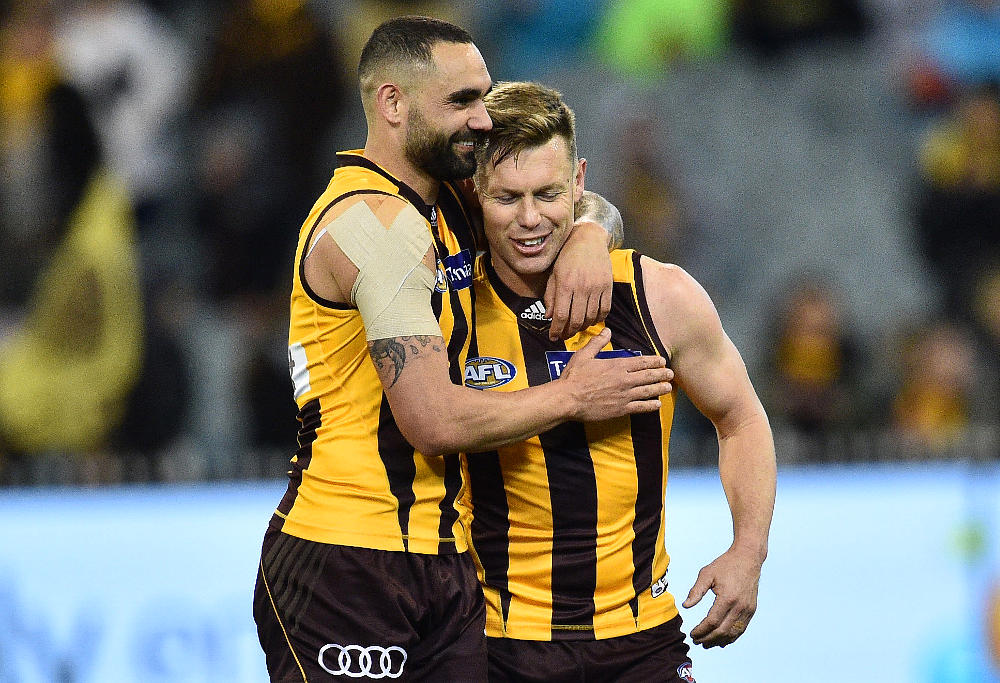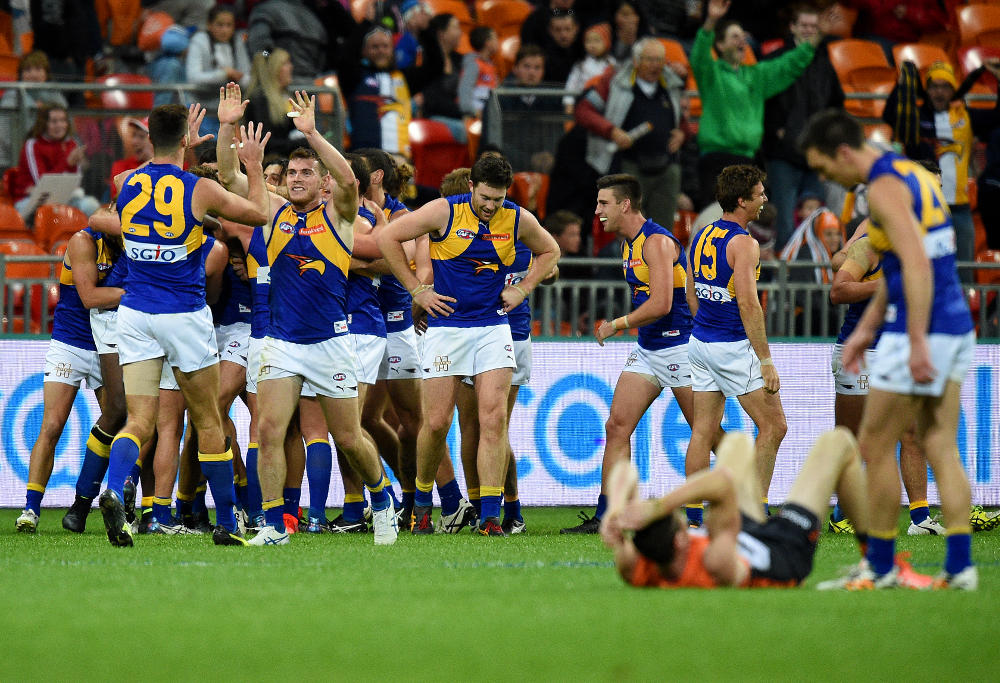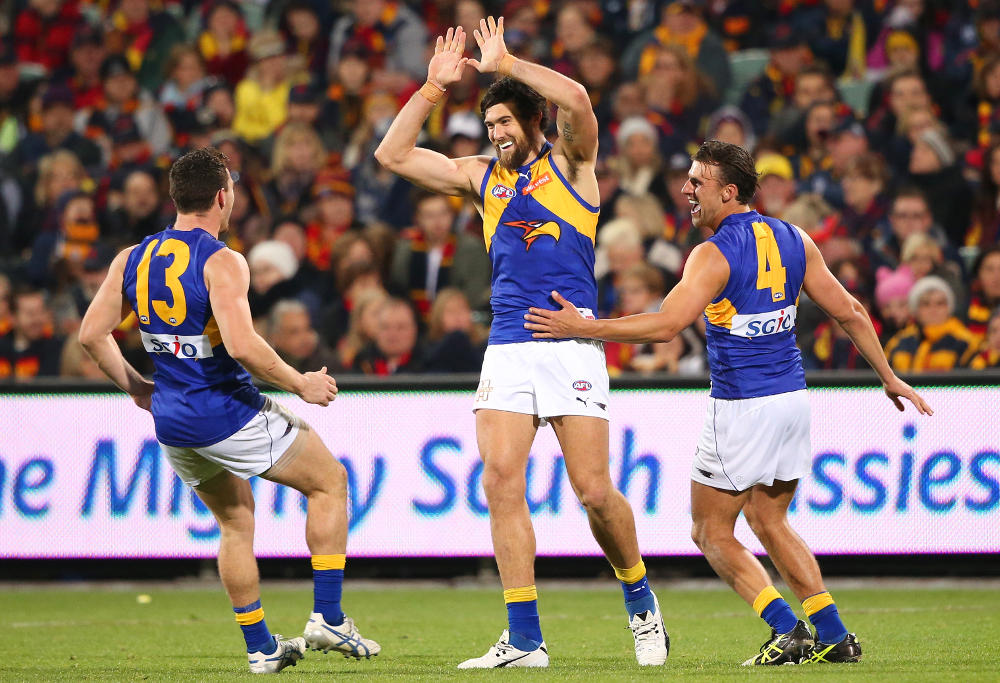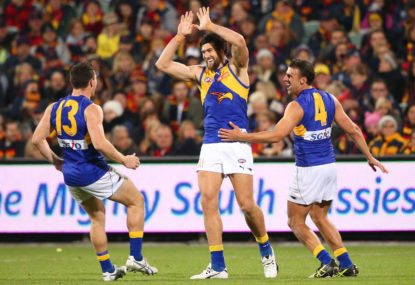“West Coast can’t win it because Nic Naitanui is missing.” Good luck with that. This common refrain of the offseason has become statement that reveals the speaker’s glaring lack of football knowledge.
The Eagles are so much more than their superstar ruckman.
If you’re only as good as your last game, then the negativity directed towards West Coast’s prospects makes a little sense.
The team had been maligned all season, openly mocked for its inability to win games away from comfortable surroundings or familiar situations.
West Coast entered Round 21 with a target on their back, with two road games and a Friday night encounter with the ladder-leading Hawks between them and the finish line. They ran the slate, beating the Giants away, Hawthorn at home and Adelaide away.
The bye week was full of talk that West Coast could make a run from outside the top four, starting against a wounded Western Bulldogs in an elimination final and followed up by a chance at redemption against a fading Hawks, albeit at the MCG.
Their guts were smeared over the Subiaco turf by the Western Bulldogs in Week 1.
The show started with a scrappy goal to Liam Picken at the 12-minute mark of the first quarter, and ended with a 20-minute near-scoreless slog that was the physical embodiment of purgatory.
West Coast’s last game was a neat encapsulation of every doubt that every pundit has posited since the team surged to premiership favouritism in 2015. The Eagles wilted under pressure; they couldn’t halt the Dogs’ momentum.
Half of the team went missing; Jack Darling did Jack Darling things, Jamie Cripps and Josh Hill had 17 possessions and kicked one goal between them, Elliot Yeo and Sharrod Wellingham dug holes and refused to come out. The Eagles were missing their exemplar, Nic Naitanui, and they will never win anything without him.

I get it. I feel it too. Coming into the game I was the right kind of nervous. Knowing the Western Bulldogs had proverbial-ed the proverbial two weeks prior against a woeful Fremantle – on the same ground, no less – all that was needed was 75 per cent of the performance West Coast had put in against Adelaide in Round 23. It was a soul-mashing defeat.
The Eagles, a team that spent the year flirting with the idea of being a contender, waited until their last game of the year to reach their most disappointing ebb. It wasn’t getting any better, either. Naitanui was gone for most of the year, second-choice ruckman Scott Lycett was facing a delayed start to the year, the core was continuing to age and for most of the list, 2015 looked like the year everything just sort of clicked. The 2016 additions, Lewis Jetta and Jack Redden, might have actively made things worse.
Then this happened.
Wait, not that one…
Sam Mitchell was traded to West Coast, for the AFL equivalent of an expired tub of yoghurt, and everything changed.
He joins a team at its demographic apex, on a deal designed with the long term in mind. Sure, West Coast are missing their champion ruckman, the one undisputed on-field leader that the opposition fear. But with Mitchell, the Eagles might have found the premiership piece that has eluded them in their now-decade-long pursuit for a fourth premiership.
The Mitchell effect
Sentiment towards former Hawk Mitchell has shifted in the past 12 months. The stocky playmaker has always been held in stupendous regard by the thinking football fan, but it seems his posthumous 2012 Brownlow Medal win has elevated him in the minds of football at large.
In a league that grows more freakishly athletic by the year, Mitchell stands out for his non-athletic traits. That’s not to say he isn’t an outstanding athlete – anyone that can play AFL football, particularly at its current pace, past the age of 30 cannot be considered anything less.
But he’s short. He’s slow. He has short arms. He has a joggers gait. He’s muscle-bound.
Mitchell’s skills are renowned, his ability to find time and space – football’s currency – unparalleled in today’s congestion-heavy meta-game. He’s averaged 28 touches a game in every season bar one (ironically, his 2012 Brownlow season) since 2009, shifting between an inside and outside role for the Hawks. Mitchell has a unique ability to hit targets by hand and foot on both sides of his body, moving forward, backward or laterally and under pressure or with clear air in which to go to work.
Plenty of players can impose themselves on a game with an act of strength, or speed, or agility. Mitchell does it with his skills, with such regularity that it has almost become predictable. Of course he’s going to execute a perfect box kick to set up Paul Puopolo with an inch of space. Of course he’s going to volley a third man up (RIP) tap 50 metres down the line down a teammate’s throat. Of course, he’s going to thread a handball between the waiting arms of three opponents.
At 34, Mitchell comes in the top 20 AFL players in this year’s Roar AFL top 50. He is a phenom, a unique player able to set the play like a quarterback without an army of 400-pound men protecting him. Had Mitchell been moved to Brisbane, sentiment towards the Lions would improve. His joining the Eagles should inspire the same positivity, but off a higher base.

The Eagles already have a Brownlow Medal-winning play-making dynamo: Matt Priddis. The veteran is all substance, with little flair or want for the spotlight, but has built himself an inside playmaking empire that few can match. Priddis won 16 contested possessions and generated 6.7 clearances for West Coast last season, both in the top five in the competition. He’s involved in five West Coast scores per game, while also executing 8.6 tackles – the most in the league by a regular player in 2016.
Together, Priddis and Mitchell are set to form one of the most damaging, potent and unpredictable table-setting units in the game. It’s already been on show: West Coast’s first JLT Series game saw Mitchell and Priddis collect 28 and 27 touches in 88 minutes of heat-affected play, linking through the middle and fishing the ball out of congestion.
I’m not sure the opposition will be able to consistently stop it once the season gets underway. Both have a clean handle and quick hands, can thread the ball by hand and have mean fake outs. It will lighten the inside load for Luke Shuey, who can instead focus on his power running out of stoppages rather than complementing Priddis as he has in the past three or four years. Andrew Gaff is free to roam. The Jack Redden experiment is put on hold for at least 12 months. The implications are immense.
The peak is approaching
Mitchell is the icing on a cake which has been baking for some time. As Ken and I discussed yesterday, West Coast’s current list was formed in the fires of the club’s illicit drugs crisis, with Chris Judd’s exit request the catalyst for a decade-long build just reaching its crescendo.
Hawthorn are the league’s leading player recycler, a reputation they are putting to the test in 2017 and beyond. But lurking in the background is West Coast, who have done just as much to augment their list with bolt-on talent in recent years.
The Eagles have been one of the most consistent buyers of established football talent on the AFL market in recent years. From 2012 to 2016, they traded for nine players and bought the services of one free agent, with 2014 the only year the team has hit up the draft exclusively.
Best or fringe 22 players Jamie Cripps, Sharrod Wellingham, Elliot Yeo, Jonathon Giles, Lewis Jetta, Jack Redden, Sam Mitchell and Nathan Vardy all began their football careers at other teams. Xavier Ellis and Cale Morton have retired since joining. All bar Elliot were bought in to fix particular needs on the list – Yeo was a lump of clay when he left Brisbane – all with an eye to contention during the primes of the team’s home-grown draft talent.
We are smack in the middle of that prime. Between 2007 and 2010, in the post-Chris Judd, post-illicit drugs era, West Coast finished third (but sold Judd for pick 3 and Josh Kennedy, 2005’s pick 4), 15th, 11th and 16th. Those years yielded Chris Masten, Kennedy, Nic Naitanui, Luke Shuey, Brad Shepherd, Andrew Gaff and Jack Darling, the core of West Coast’s team.
The sum total of it all is the Eagles are currently the AFL’s most experienced and second oldest full list (excluding rookies) in the competition, rising up from seventh and 12th respectively in the first year of coach Adam Simpson’s reign. Their time is now.
Change it up
West Coast rose in 2015 on the back of coach Simpson’s novel man-zone defence scheme, that saw loose defensive one-on-one assignments and 18-man accountability. It was coined the ‘Weagles Web’ in reference to the way in which West Coast would position its defenders across the ground to force a high kick, before closing in on the ball once a long kick was forced.
Teams cottoned on to it last year, and the Eagles’ Defensive Efficiency Rating dropped from +17.5 to +14.1, with a raw score of 76.3 compared to 71.5. The team leaked an extra two marks inside 50, and an extra 5.6 inside 50 entries, per game. They were still a top-six defence, but the web wasn’t the fearsome tactical advantage it proved to be in 2015.

That looks set to get worse this season, given the rise of the Western Bulldogs and the AFL’s inimitable drive to follow the leader.
Dogs coach Luke Beveridge’s system is built to beat the aerial zones, and the JLT Series showed more teams are going to try and pinch elements of it – particularly moving the ball forward by hand rather than foot. It will require an adjustment at West Coast; presumably the focus of the web structure will shift to stopping ground balls as well as intercept marks.
West Coast’s midfield could also be expected to move the ball by hand a little more frequently in 2017. The Eagles had the second highest kick-to-handball ratio in the league in 2016, and were around 30 per cent more kick happy than the Western Bulldogs.
In attack, the Eagles would also be expecting, or demanding, a more even contribution from its forward line. Josh Kennedy is one of the best two or three key forwards in the game (depending on where you rate Gold Coast’s Tom Lynch and whether you consider Lance Franklin a key forward), but can he kick 80-plus goals for a third straight year? History says it will be a challenge: Matthew Lloyd was the last player to do it in 1999-2001.
It will up the onus on Jack Darling to provide more of his own drive, rather than acting as a flanker for Kennedy. Darling’s best goal kicking year (53) came in 2012, when Mark LeCras was out with an ACL tear and Kennedy missed much of the season. He likely won’t get close to that, but a repeat of his 2016 form (44 goals) with more marks and more disposals would fit the bill.

The injection of Mitchell, and return of Dom Sheed from a near-season long injury in 2016, should see LeCras play much closer to goal this season. At his best, LeCras was one of the best mid-sized forwards in the game, but his gradual creeping up the ground over the past few years has meant his influence on the scoreboard has waned. That should change this season.
Jamie Cripps and Josh Hill are a unique small-forward pairing, but rely on being fed the ball more than any other in the league. They kicked 52 goals and had 24 touches per game between them last year, which is about one and a half good players.
There’s unlikely to be many changes throughout the year. Yeo, Sheed and Chris Masten tend to rotate through the final half forward spot, but play predominately on the ball, leaving a resting ruckman to fill the sixth forward line post. It’s proven an effective mix, and should be well fed by a Mitchell-Priddis-led clearance-winning midfield.
A powder puff away schedule
The biggest knock on West Coast over their recent run has been an inability to win against top-eight opponents away from home. That should have been blown out of the water in those final few rounds of 2016, but reputations are sticky.
Fortunately for the Eagles, their slate of away opponents has gone from difficult to manageable. Last season, West Coast played Hawthorn, Sydney, Geelong, the Western Bulldogs, Greater Western Sydney and Adelaide away from home, going 2-4 with a percentage of 80 (it was 0-4 and a percentage of 65 in their first four).
The only finals team the Eagles avoided travelling to was North Melbourne. This year, they face the Roos, Hawks, Dogs and Giants – North are a top-eight team in name only, and no one is beating GWS at home so it’s mostly a wash. Instead, West Coast host a range of their toughest opponents, including two of them (Sydney in Round 4 and the Western Bulldogs in Round 8) who travel to Perth on six-day breaks. No fixture is easy, but West Coast have been treated kindly by AFL House this season.
Oh champion, my champion
The macro settings are all right for West Coast: an experienced, familiar core, strong key position stocks, a kind fixture, a competition that looks as even as it has for some time. The addition of Sam Mitchell would appear to be the win-now move to put the team over the edge.
But what do West Coast do about their ruck situation?
Nic Naitanui will be out until at least Round 17, according to the latest report (from December), if he is able to return at all. Scott Lycett dislocated his shoulder in a WAFL trial match over the weekend, and looks set to miss the first half of the season at the very best.
West Coast picked up Jonathon Giles from Essendon for practically nothing (they swapped their pick 54 for pick 57 and Giles from Essendon), gave up slightly more for Nathan Vardy from Geelong (pick 68), and bought the services of exhumed corpse Drew Petrie for nothing. It is a horror show compared to the two-pronged attack of Naitanui and Lycett.
Lycett and Giles formed a solid pairing in the games Naitanui missed last season, but with Lycett’s availability pending the Eagles have a decision to make. Talk seems to be Giles will be sidelined for the new pairing of Vardy and Petrie in Round 1. With Priddis and Mitchell roving the packs, Petrie could ruck full-time and the Eagles will still scoop up and dish out the lion’s share of ground balls.
Well might they, because Naitanui or no Naitanui, West Coast’s time is now.

































































































